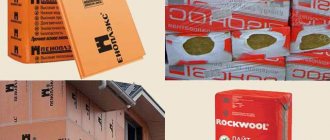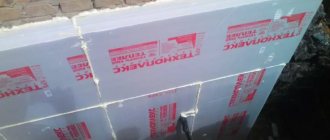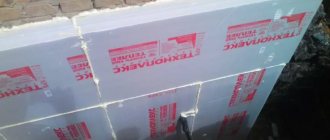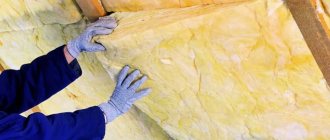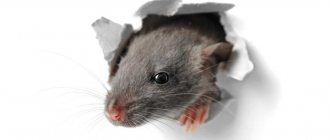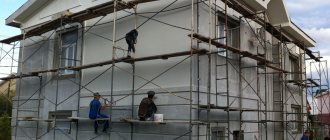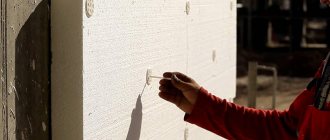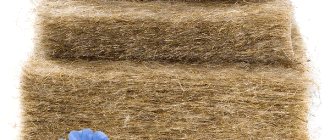Penoplex is a modern material with unique thermal insulation properties, which is ideally suited for insulating foundations, walls and ceilings and is in great demand among buyers. Therefore, when choosing insulation for a summer house or country house, many people have a logical question: do mice eat penoplex? The author of the VredStop website found the answer: rodents do not eat insulation, but, trying to get into the room, they make passages in it and destroy the structure of the material. This reduces its thermal insulation properties.
Why do mice like to live in penoplex?
Penoplex (extruded polystyrene foam) is a finely porous material with numerous air-filled cells.
The insulation is inexpensive, but at the same time it is durable, has a low level of thermal conductivity, moisture resistance and resistance to fungal infections. It is also important that polystyrene boards do not swell or warp when painted, treated with glue or plastered. If the basic rules are followed when installing thermal insulation and the insulation is protected from rodents, it can last fifty years or more. Mice appear in the house in the fall, with the onset of the first cold weather, when there is nothing left to profit from in the fields. This is the time to think about creating a warm mink and accessible food. Penetrating through cracks, holes, and ventilation holes in a person’s home, the animals easily gnaw through pliable polystyrene.
As you know, rodents do not eat synthetic insulation, but feed on food products and waste. Polystyrene slabs are just an obstacle on the way to the desired food, which can always be found in a summer house closed for the winter, in a trash can or in the kitchen of a careless housewife. By gnawing labyrinths in the insulation, mice thereby destroy the structure and reduce the functionality of the material, literally turning it into dust. In this case, the damage can be more than 80%.
Mice, unlike rats, move in groups and live in families. If one individual appears in the house, a dozen more will come running after it. Therefore, if you hear a characteristic crunch or squeak, you must immediately take action.
What's the attraction?
According to many experiments conducted and the experience of numerous ordinary people who use soft material for construction needs, which are all types of mineral wool, the toothy guards are not particularly afraid. Even the notorious glass wool - a rather prickly and skin-irritating substance - is not an obstacle for the ears. Moreover, in all these insulation materials, the newborns feel comfortable, make moves with pleasure and create cozy and warm nests inside.
In addition, rodents, although not entirely intellectually developed creatures, understand perfectly well that soft cotton wool is the best place to organize your own house, because it:
- doesn't rot,
- does not spoil
- has good ventilation properties,
- it's always warm and dry there,
- and the structure of the fibers holds its shape perfectly.
But mice do not live in ecowool, despite the fact that it is made of organic and seemingly edible material. Why? It's simple: in addition to cellulose, the insulation contains orthoboric acid (borax), a chemical that causes extreme thirst and discomfort in animals. If a mouse suddenly decides to settle there, it will soon move to another, more suitable place for it.
By the way, there is an opinion that no matter what the soft insulation is, in terms of its constituent ingredients, mice can live in it purely hypothetically!
Therefore, when erecting a structure, they think in advance about carefully sealing cracks and technological holes so that rodents do not have the opportunity to climb inside and make a warm nest for themselves.
It is worth noting that official manufacturers of mineral wool, for example, Techno, Parok, Izover and some others, do not indicate its resistance to rodents in their descriptions of the characteristics of the material. At the same time, Rockwool claims the opposite and confidently reports that mice are not interested in their product. Although, most likely, the developer is disingenuous, since there are many messages from home repairers refuting this fact.
In connection with the above, we can conclude that mice not only breed in mineral wool, but also feel at ease there.
What is penoplex
Penoplex is a lightweight material and has good sound insulation
Penoplex is a high-tech material produced by extrusion. During a high-temperature operation, under intense pressure, granulated polystyrene is foamed and then extruded into even, smooth slabs.
The catalyst for this operation is carbon dioxide with freon, after which the volatile substances evaporate and a finely porous cellular material is formed with cells isolated from each other and filled with air. The result is a product that is cheap, durable and reliable.
The range of application of this heat insulator is very wide: insulation of loggias with penoplex, facades, floors. Penoplex is also used for laying under railway tracks and airfield landing pads (you can read detailed information about what penoplex is used for here).
Material properties
Penoplex is laid on a concrete screed after waterproofing with polyethylene or roofing felt.
The technical characteristics of penoplex make it attractive for use in the construction of low-rise structures and private and industrial construction:
- the most important thing is the reduced thermal conductivity index, its value of 0.03 W*m*0C can compete with any insulation and will remain a winner;
- increased resistance to transpiration (penetration) of moisture - only 2 cm of penoplex corresponds to roofing felt in terms of vapor permeability;
- Due to extrusion, the mass is homogeneous, so evenly distributed cells significantly increase its strength. Even under very high loads, its parameters are almost unchanged;
- high moisture resistance - liquid is absorbed only in places of cuts where the integrity of the cells is compromised;
- penoplex is not subject to rotting and decomposition, mold does not develop in it, which indicates the high biostability of this material.
Temperature conditions that allow the use of penoplex range from -50 to +75 degrees Celsius, but for each type of penoplex the temperature limits are indicated in the instructions.
You need to know: in order for the dimensions of the penoplex slabs to remain unchanged, the temperature specified in the product data sheet must be observed. If it is overheated, its characteristics may change.
Features of insulation
In addition to the previous properties, we can name other qualities that receive special attention:
- environmental friendliness;
- ease of installation of penoplex slabs: they are easy to cut, and installation can be done in any weather;
- The service life of this material, taking into account atmospheric influences, is 50 years. The studies carried out under severe freezing and thawing conditions provide such a guarantee even with a margin.
When independently insulating a loggia from the inside, the finishing material can be applied using “wet” and “dry” methods
Chemical activity
Of particular note is its low chemical activity. This is another positive side of the material, since it is not influenced by many compounds:
- alcohol-based paints;
- different types of acids;
- salt solutions;
- chlorine;
- various oils and paraffins;
- cement mortars.
But there are also substances, although there are not many of them, that, when interacting with penoplex, can cause it to change shape and even dissolve.
When insulating the adhesive for work, it is important to choose the one indicated in the instructions
This is important: when choosing a solvent for painting, you should carefully study the instructions in order to avoid deformation and shrinkage of the material.
Characteristics of brands
Types of penoplex are represented by several brands; they include a set of characteristics inherent in the construction site where it will be used. Then you can achieve maximum capabilities from the material in each individual case.
Classified according to size and density:
- density, available parameters - 31-45 kg/m3;
- slab length -120 cm;
- thickness ranges from 5 mm to 3 cm;
- The width of the slab is usually 60 cm.
The insulation is thicker, it is preferable to lay it in at least 2 layers, in a checkerboard pattern, then the strength and uniformity of the coating will be higher
We recommend reading: How to properly insulate a floor with your own hands - the best ways
Penoplex45
This type is widely used not only in private construction, it is in demand for the construction of roads and runways at airfields, since its density is the highest - 45 kg/m3. Such slabs reliably protect them from frost and thawing, as a result the surface remains smooth and is less damaged. When constructing load-bearing types of roofing, playgrounds and even parking lots are installed on them.
Please note: in order to purchase a product worthy and necessary for the intended purposes, you must check all the documents and make sure that the technical characteristics of the penoplex correspond to the proposed material.
How to protect penoplex from rodents?
It is necessary to take care of protecting the heat insulator from the invasion of rodents and insects at the construction stage.
- If possible, it is necessary to lay a strip foundation of concrete blocks, and fill the perimeter with broken glass.
- For insulation, it is better to take thick polystyrene, which mice are reluctant to gnaw.
- When installing insulation boards, carefully seal joints and cracks.
- Foam boards should be covered with a fine metal mesh or the lower part of the house should be upholstered with thin iron to a height of 50–60 cm. External finishing with siding or other similar materials will also save you from mice.
However, most often mice appear in an old house, the builders of which had no idea about such a scourge and did not provide protection from rodents and insects. In this case, to prevent damage to the insulation, the following measures must be taken.
- Find and seal cracks and holes in the facade, through which gray pests could theoretically enter the house from the street. At the same time, do not forget that a mouse can fit into a hole with a diameter of 0.5 cm.
- Place protective nets on the ventilation windows in the foundation.
- The bottom layer of penoplex is covered with a metal mesh with small cells. The most suitable cell size is 10x5 mm, wire thickness is at least 0.5 mm. It is better to use more flexible aluminum mesh, but steel mesh will also work.
- Put everything in order in the kitchen and utility room: put all products in containers inaccessible to mice - pour cereals and flour into glass jars with lids, place vegetables in closed enamel pans, store products and cooked food only in the refrigerator. The trash can must have a lid. If the mice have nothing to eat, they will quickly move to a more suitable place.
- To drive pests out of your home, you can use an electronic repeller. This device emits ultrasound, which affects the psyche of animals. Having heard the signals sent by the repeller, mice tend to quickly leave the room and get away from the irritant. However, you must be prepared for the fact that after turning off the device, uninvited guests will appear again.
- Boric acid can be sprinkled in areas where pests emerge and around the perimeter of the home. But it is important to ensure that pets or children do not suffer from the poison - this method is applicable only if no one lives in the house temporarily. Moreover, we should not forget that the corpse of a poisoned mouse can remain inside the foam and spread an unpleasant odor throughout the room for a long time.
- The surest and safest way is to get a cat.
- You can repel pests with the smell of dried chamomile, wormwood, black root, wild rosemary, elderberry and other plants.
If you cannot cope with rodents on your own, there is only one way out - to invite specialists to carry out complete deratization.
Protecting foam from pests
Polystyrene foam is a very convenient material for thermal insulation and sound insulation. But it is various foam plastics that are most susceptible to attack by mice and rats. These are materials such as extruded polystyrene foam, polyurethane foam, penoizol, penoplex. These materials are artificial, so they are not suitable for mice as food, but they chew them and turn them into dust. In the resulting voids, rodents make nests for themselves. To protect it from rodents, you need to take certain measures:
- It is necessary to choose dense types of polystyrene foam for insulation, since it is inconvenient for mice to gnaw on dense material.
- Proper installation of the foam is necessary. It must be carefully puttied and sheathed using special materials, selected individually. The goal of proper installation is to prevent the appearance of cracks, since rodents enter the home through the cracks.
- All holes must be sealed with foam.
- It is advisable to provide metal sheathing along all walls at pest entry level. They won't be able to handle metal.
These measures must be taken into account at the construction stage. If they have not been accepted, all that remains is to take actions aimed at repelling rodents:
- The easiest way is to get a cat. Just the smell of a cat in the house repels mice.
- You can install an electronic repeller, but if the area of the house is large, one device will not be enough, you will have to install several. Such repellers emit ultrasound of various frequencies, which causes fear in rodents and forces them to leave the building.
- All food supplies must be kept out of the reach of rodents.
- The home must be kept clean.
Folk remedies are effective to protect polystyrene foam. They are based on the use of various plants that repel rodents with their smell. These are plants such as pine needles, tobacco, mint, wormwood. These dried plants can simply be scattered in corners. During the construction phase of a house, you can treat the foam with lime or red pepper.
Some people use boric acid to repel pests, but its effectiveness in controlling rodents has not been proven.
If none of the above methods help, you need to contact the sanitary and epidemiological station, whose employees will come and carry out a complete disinfection of the premises and the elimination of all rodents.
Source: svekrovi.net
How to treat penoplex?
To protect the insulation from ants and rodents, you can treat the surface of the penoplex with copper or iron sulfate or borax solution. It’s just a pity that such labor-intensive work will not bring 100% results. Under the influence of the sun and water, the impregnation will quickly wash off, and along with it, the seemingly reliable protection of the insulation will disappear.
Some experts advise painting or covering foam boards with glue. It will be more difficult for mice to move along slippery walls, and it will be more difficult to chew through a layer of paint than unprotected material. In addition, the smell of paint and glue will repel pests.
If none of the above methods helps, you need to take drastic measures - remove the destroyed thermal insulation material and re-insulate the house using materials that are resistant to the sharp teeth of rodents: foam glass, foam concrete, ecowool.
And even though mice do not eat penoplex, they cause enormous damage to the home by making numerous tunnels, destroying insulation and deteriorating thermal insulation. Reinforcement with mesh, treatment with insecticides and storing products in a place inaccessible to pests will help protect polystyrene foam from rodents.
Conclusion
Unexpected guests can disturb the peace of the legitimate inhabitants of the house. Constantly feeling someone else's presence is unpleasant for everyone. Even if this alien is not visible behind the wall. Mice leave an unpleasant odor, noise, and infection. It is imperative to fight them. They chew through insulation panels and leave behind debris. The necessary measures are taken to protect the foam. Mice love to sharpen their teeth on it, build trenches and labyrinths. It is better to think about this right away, before building a house.
If you use more durable insulation materials instead of polystyrene, you can forget about their protection. For this purpose, the house is insulated with foam concrete, ecowool, expanded clay or foam glass. They have a composition that rodents do not like. You need to have iron teeth to gnaw through foam concrete or expanded clay. Rats would be better off finding other housing with foam insulation.
To keep pests away from your home, keep it clean and do a thorough cleaning every week. Basements and attics must also be properly maintained. It is better to take trash and unnecessary things out of the house so that mice do not make houses for themselves. If you prevent the appearance of unwanted guests, then you won’t have to worry about it.
Source
We consider thermal insulation materials
To find out the “preferences” of rodents regarding various insulation materials, you need to know a simple rule: in search of a place for a nest, the mouse will follow the path of least resistance and begin to gnaw on softer material. First of all, let's make a list of insulators used to increase the energy efficiency of residential buildings:
- solid natural materials – expanded clay, vermiculite, foam glass;
- blocks made of foam and aerated concrete, wood concrete;
- artificial polymers - foam plastic, foamed polyethylene and polyurethane, extruded polystyrene foam (aka Penoplex);
- building materials based on glass and basalt fibers - mineral and glass wool;
- new cellulose insulation – ecowool.
This is what ecowool thermal insulation looks like
Note. For obvious reasons, the list does not include rarely used perlite concrete products and any fiberboards.
The ability to resist pest attack is affected by 3 characteristics of a thermal insulation product: density, chemical composition and flowability. Based on these characteristics, we will consider all types of insulation.
Vermiculite and expanded clay
These two building materials, and even foam glass, are the best option for protection against rodents. Their main advantage is their high density and flowability, which does not allow them to make a hole. The main condition is that the insulating layer must be well compacted so that the gaps between the pebbles are minimal. Solid blocks of foam glass cannot be chewed through due to their hardness.
Covering with foam glass panels
The characteristics of insulation look like this:
- The density of expanded clay gravel ranges from 200 to 800 kg/m³ depending on the size of the fraction, thermal conductivity is 0.11–0.21 W/(m•K).
- Crushed vermiculite stone has a density of 250 kg/m³ with a thermal conductivity of 0.13 W/(m•K).
- The foam glass indicators are respectively 160 kg/m³ and 0.06 W/(m•K).
A layer of expanded clay inside the wall leaves no chance for pests
Mice do not eat expanded clay with vermiculite and all products based on them, for example, expanded clay concrete. Another thing is that the thermal insulation properties of these materials are low, and their mass is large. To replace 100 mm of foam plastic with a thermal conductivity of 0.04 W/(m•K), you need to fill in a layer of expanded clay gravel of at least 30 cm, which increases the thickness and weight of the structures too much. Foam glass insulation is effective, but not cheap.
The following conclusion suggests itself. The listed materials provide almost 100% protection against mice, but are impractical or expensive to use. That's why they are inferior in popularity to the next category.
Lightweight concrete blocks
Theoretically, mice are able to chew through foam blocks and wood concrete, but they do this extremely rarely, since the materials are quite hard and dense:
- wood concrete products – 300–800 kg/m³;
- aerated concrete – from 400 to 500 kg/m³;
- foam block - 600-1000 kg/m³.
In terms of thermal insulation parameters, light blocks are comparable to expanded clay - the thermal conductivity coefficient lies in the range of 0.1-0.2 W/(m•K). At the same time, they have one big advantage: block products are structural building materials. That is, it is possible to build external walls from aerated concrete that can bear significant loads. Therefore, in recent years, the popularity of wood concrete and various foam blocks has been constantly growing.
Note. The lower the thermal conductivity of the material, the better its insulating properties.
Polymer insulation
The answer to the question of whether mice chew foam plastic has long been answered: definitely yes. It so happens that products with the best heat conductivity indicators - 0.04-0.045 W/(m•K) have a low density - from 15 to 35 kg/m³. Therefore, rodents take great pleasure in settling inside polymer slabs at the slightest opportunity.
The same answer awaits homeowners who are interested in whether rodents eat polystyrene foam (otherwise known as Penoplex). Since its hardness and density, equal to 30-50 kg/m³, is greater than that of foam plastic, mice are not so willing to make holes in it. But the thermal characteristics of the material are even more attractive - 0.037 W/(m•K), and gray pests feel it. Especially for skeptics, we will show a photo of a polystyrene sheet with a mouse hole.
The animal has just begun to gnaw a hole in one of several sheets folded in a stack
Rodents have a similar attitude towards polyurethane foam and polyethylene foam - if necessary, they make nests in these insulation materials. Hence the conclusion that applies to all polymers: it is unacceptable to refuse lightweight and energy-efficient materials because of mice, but you will have to think carefully about how to protect them from damage.
We recommend reading: Plastic air ducts: installation features and dimensions, products with round and rectangular sections
Mineral wool
Basalt and fiberglass products cause the most controversy - some users claim that rodents “love” mineral wool, the other half proves the opposite. It is impossible to refuse to use these materials for 2 reasons: they do not burn at all (except for glass wool) and allow water vapor to pass through, and therefore are good friends with wooden structures.
In low-density rolled mineral wool, mice move freely
Let us present our reasoning in the form of theses:
- The density of mineral wool insulation varies over a wide range - from 40 to 200 kg/m³. Practice shows that mice hardly touch basalt slabs, whose specific gravity is more than 80 kg/m³.
- Unlike previous building materials, the chemical composition of fiber products includes synthetic binders - carcinogenic resins based on formaldehyde. This makes the product not as “appetizing” as expanded polystyrene.
- Roofing glass wool and mineral wool in rolls are vulnerable to rodents due to their soft structure. They make nests in the material, despite the presence of formaldehyde resins and tiny glass particles.
- Ecowool, made from cellulose fibers, is susceptible to mouse attacks to the same extent, since it cannot boast of high density.
Reference. Manufacturers of ecowool claim that they add boric acid to its composition, which prevents the colonization of all kinds of living creatures.
Conclusion. Maximum protection against the penetration of mice will be provided by slab basalt insulation with a specific gravity of 100-145 kg/m³, and it is recommended to use it whenever possible. There are currently very few cases where such dense mineral wool was damaged by pests.
How to protect an insulated house from rodents
It makes no sense to talk about how to get rid of mice using rat poisons and all sorts of mousetraps, especially when they live in the thickness of the outer walls. The best way to preserve the integrity of the thermal insulation structure is to keep the mouse out of the house, although a 100% guarantee cannot be achieved. What is recommended to do:
- Try to build houses from warm structural materials - aerated concrete or wood concrete. If you maintain the required wall thickness, you will not have to insulate them.
- To insulate roof slopes and ceilings, use dense basalt wool or fill the attic with expanded clay.
- To protect polymer and other soft insulation materials, the foundation and base of the house must be enclosed in a fine steel mesh coated with zinc.
- Make a basement ebb in the form of a metal canopy around the perimeter of the building. It will prevent the mouse from climbing up the wall to the roof.
- Install an ultrasonic repeller in the attic.
Such an overhanging canopy is quite difficult for animals to overcome
Also, do not refuse the help of your smaller brothers - domestic cats. For a successful hunt, they need to provide access to closed cavities, the attic and basement, not forgetting to remove all mousetraps. More information about protective equipment is described in the video:
What to do if the foam is already damaged
Pests often damage wall cladding. The owners notice this when they need to change it. What do enterprising people do in this case? – Replace damaged polystyrene foam boards with new ones. To prevent pests from entering the premises again, the necessary measures are taken.
When installing the base profile, there is no need to dismantle the slabs. Through a layer of reinforcing mesh, a rat cannot grab onto polystyrene or penoplex with its teeth. This material is extruded polystyrene. But this does not stop gray mammals. They can also damage the untreated extruded composition, like regular polystyrene. Only the metal mesh must have small holes, otherwise the animal will crawl through them. Effectively used to cover polystyrene foam, aluminum mesh.
Do mice live in polystyrene foam or polystyrene foam?
According to some studies, polystyrene foam and its derivatives do not have any harmful effects on the health or well-being of mice. Rodents successfully build nests in polystyrene foam and polystyrene foam.
Due to the presence of such materials, the pest population can increase significantly.
But at the same time, there is an alternative opinion that they gnaw through these materials only to pass through barriers, but the animals avoid living in them.
As an afterword
What can you advise the owners of dachas and country houses if they have a problem - mice chew on foam plastic (expanded polystyrene). First of all, don't panic. A mink discovered in time should serve as a signal for immediate action. Check your home regularly for rodents and be vigilant. This way you can avoid serious problems and equally serious costs.
Secondly, if you have the opportunity, when building a house and insulating it, do not forget to cover a layer of polystyrene foam with a protective fine-mesh mesh. This way you will protect the polystyrene foam not only from rodents, but also from birds, which can also cause damage.
Thirdly, take the advice of experienced homeowners and install an ultrasonic mouse and rat repeller. Believe that the costs will not be in vain and will more than pay for themselves. The device is not that expensive, it is quite effective and does not require special maintenance.
Don't forget about the cat. There may even be several of them if you have a large farm. Our grandparents always kept a cat in the house and were pleased with the result. Cleanliness is not only a guarantee of health, but also a guarantee of your quiet life in your summer cottage. Mice eat what you throw at them, they eat with appetite, they eat a lot - don’t forget about it!
In addition to the fact that they eat insulating material, they can infect you with some kind of infection (hemorrhagic fever, for example). Therefore, after exterminating mice, be sure to carry out thorough disinfection. It is better not to do this yourself, as there is a risk of poisoning from chemicals. There are specialized companies involved in pest control. They will efficiently destroy rodents and disinfect the area.
Insulation that mice don't chew
To prevent mice from making moves in the walls, it is useful to use the following materials:
- Foam concrete. It is a rigid, but light and porous insulating material. It is not suitable for pests gnawing holes. At the same time, buildings built using such material are warm, durable, and also environmentally friendly.
- Expanded clay. This insulation has proven itself well and has been popular for many years. Its basis is a special type of clay. It consists of granules, the size of which varies from 1 to 40 mm. Expanded clay is used to insulate walls and floors. This material is not suitable for mice or other rodents. It is difficult to move around, you feel a lack of air, and small particles clog the organs of the respiratory system.
- Ecowool. This is a lightweight fibrous building insulation material based on orthoboric acid. It can cause lung damage and dehydration, which leads to the death of mice. This material is not dangerous for humans and pets. It is suitable for insulating both external surfaces and walls inside a living space.
- Foam glass. This material is a foamed carbon mixture of waste glass. During production, glass cells are formed that fit tightly together. This fiberglass has good thermal insulation properties and is not afraid of moisture. In addition, it is convenient to use and is also rodent resistant. When a mouse tries to bite through such insulation, it immediately injures its oral cavity, so it quickly abandons this idea.
If a rodent population begins to develop in the thermal insulation layer, then urgent measures must be taken.
Mice will have no incentive to live in a particular insulation if there is no available food source.
At the same time, heat insulators must be reliable and resistant to pests. The same cannot be said about polystyrene foam, penoplex or extruded polystyrene foam.
Is polystyrene foam harmful or not to human health?
What insulation should you use to avoid turning your home into a time bomb? After all, any thermal insulation material, with the exception of moss or flax, which is used to insulate wooden log houses, is a synthetic material, which means it contains toxic substances that are potentially dangerous and can harm human health. Particular discussions among users are caused by such questions as “is polystyrene foam harmful as insulation indoors” and “does the harm of extruded polystyrene foam exceed the harm caused by compressed polystyrene foam (ordinary polystyrene)”?
Is the buyer doing the right thing by giving preference to such an easy-to-use, relatively cheap and popular polystyrene foam?
It is dangerous for health to insulate a balcony from the inside with polystyrene foam
Penoplex and safety
Manufacturers and sellers constantly talk about the safety of the material, but is this true? Is penoplex harmful to health?
Many argue about the environmental friendliness of this material, explaining that even when treated with a fire retardant, it is susceptible to combustion. One cannot argue with this, since many of the objects around us cannot withstand fire.
The flammability class of penoplex is usually G4 or G3
Whether it can ignite on its own or contribute to a fire is another matter. The question here is clear - no. But when ignited, it produces a lot of acrid smoke and releases toxic substances. However, it ignites slowly, so before it catches fire, a lot of time will pass, and the fire can be put out in time.
Another disadvantage that has a negative impact on the human body is the destruction of the material that occurs under unfavorable operating conditions. Penoplex not only loses its properties, it oxidizes and begins to release toxins into the air. This happens when low-quality products are selected, or installation rules are violated.
Therefore, it is important to choose only material manufactured in accordance with the technology, adhere to the rules when installing, and do not use incompatible compounds. Only under these conditions will it fulfill its purpose without harm to humans.
For starters, some information from the section on market economics
Dear friends, do you think I have described all the wonderful characteristics of such wonderful materials?
No! I left one property for a snack. But in fact, this property is perhaps the main one. Both polystyrene and penoplex are phenomenally cheap to produce
. That is why in any box with a TV, or with a computer, or even with furniture, this polystyrene foam is simply missing.
Sellers of building materials especially like this property, since this material allows them to put into practice the basic principle of business - buy low and sell high!
Additional materials
- Articles about expanded polystyrene
- List of reader questions related to polystyrene foam in one way or another
- Classification of existing thermal insulation materials
- materials on wall insulation
Thank you for your attention. Your author is Dmitry Belkin. All pictures are taken from Wikipedia. Their use here is permitted by the author
Their use here is permitted by the author
All pictures are taken from Wikipedia. Their use here is permitted by the author.
Article created 01/09/2012
Article edited 09/05/2013
How to protect your home?
To maximize the protection of your home, always consider carefully sealing cracks and service openings. Then any rodents will not simply have the physical ability to live in mineral wool.
Do rodents live in mineral wool?
Official manufacturers are silent about such a point as resistance to any rodents; they simply try to omit it. Although if you look at numerous messages on construction forums, craftsmen complain and talk about such an unpleasant moment.
So what needs to be done to create a reliable barrier, what do mice dislike the most? In first place, oddly enough, is clay, which is processed according to a certain scheme and formed into granules. They really don’t like such a place for their home, especially if you use a small fraction. The reason is quite simple and banal. When rodents begin to move on unsteady surfaces. They simply fail. Among other things, being in dusty expanded clay for a long period of time, they have nothing to breathe due to the fact that the airways are clogged. Next, let's turn our attention to foam glass. Its manufacturing technology is as follows:
- Steam the glass.
- Next comes glass foaming.
When foam glass hardens, it hardens as much as possible and is not susceptible to rodent teeth. Foam concrete is also widely used. It is also considered an excellent barrier.
Foam glass
Solid insulation is of course the best way to keep rodents out. But at the same time, the level of its thermal indicators is an order of magnitude lower. Therefore, use and select a material not based on its rodent resistance.
We recommend reading: Air conditioner pump or drainage pump: principle of operation, bulk, storage and flow
What do rodents not like?
But really, what kind of insulation is not chewed by mice?
In first place, perhaps, we can put expanded clay - clay, processed in a special way, formed into granules of different sizes. Rodents do not like it as a place to build a home, especially if a small fraction is used. The fact is that when moving on an unsteady surface, mice fall into it, and besides, a long stay in dusty expanded clay clogs the animals’ airways and they become unable to breathe.
In second place is foam glass - it is made by steaming and foaming glass. When hardened, such material becomes too hard and does not lend itself to mouse teeth.
Foam concrete is another material that is an excellent barrier for the gray army of rodents. The solid mixture of sand, cement, water and foaming agent has a hard and porous structure, which makes it difficult for mice to gnaw passages.
What is the attractiveness of the material
But really, why do mice chew foam? There are at least five reasons for this.
- Everything is elementary. A plastic material with excellent thermal insulation properties is ideal not only for insulating a human home, but also for arranging rodent nests, where they settle without a twinge of conscience. Other building materials have similar properties: penoplex, expanded polystyrene, which mice gnaw for the same purpose.
- Even if the gray animals do not intend to live in foam plastic, they will still use it to create their own labyrinth. Well-trodden paths are corridors along which you can walk without fear between the nest and the kitchen or pantry, where many tasty and edible human supplies are stored.
- The constant growth of the incisors causes the animals to gnaw on surrounding objects.
- House mice can damage material in stressful situations: for example, during strong noise, as a result of a sharp increase in the number of individuals in the population, when the struggle for food and shelter begins.
- Exploratory behavior: It has long been proven that when they come into contact with something new and unknown, rodents try to try an unusual object on their teeth.
What insulation materials are not a barrier to mice and rats?
We've become familiar with sustainable materials, but what insulation materials should we not use in our home? There are many of these, mice feel very comfortable in them. Rodents easily gnaw holes and set up nests, although they rarely eat insulation. The worst material for insulating a house is polystyrene foam. Thorough treatment of the insulation with boric acid or copper sulfate will help against pests.
Types of mineral wool: glass, stone (basalt)
Mineral wool has high heat-insulating properties; it is obtained by processing slag and some rocks with additional impurities. One of the varieties of mineral wool is glass wool, which was widely used as insulation in Soviet times. It is elastic, durable, breathable, frost-resistant, and fireproof. Fungus and mold will never appear in it, but mice often appear. Rodents do not eat glass wool, because it is very prickly, but they easily make long passages in it and build nests.
Today, glass wool has been replaced by stronger and safer basalt (stone) wool. It is made from the remains of rocks by rapid melting. Its soft fibrous structure, thermal conductivity and environmental friendliness make it a favorite habitat for rodents. They settle inside the material, which leads to a decrease in the quality of thermal insulation of the house. No mineral wool is suitable for insulating residential premises.
Polystyrene foam and polystyrene foam
Foam plastic attracts rodents with its texture and smell; in a short time they can turn up to 80% of the insulation into dust. Mice not only settle in it, but also store food reserves inside, which makes a person’s stay in the room unbearable. Polystyrene foam is very easy to install and is inexpensive, but before use it must be properly prepared. Foam boards can be covered with fine-mesh metal mesh, but this is too expensive. Experienced builders advise dousing them with liquid concrete solution, which prevents the appearance of rodents.
Instead of polystyrene foam, you can use polystyrene foam, which is more resistant to mouse teeth. It is made from the same raw materials as polystyrene foam, but using more modern technologies. Special fire-retardant substances are added to it at high temperatures, enriched with carbon dioxide and extruded. The resulting mass hardens and is cut into slabs of the required size. Expanded polystyrene has a higher density, lightness and ease of installation. It has excellent thermal insulation, resistance to moisture and frost, but the thicker the slab, the more readily rodents breed in it.
Polyurethane foam
Unfortunately, the answer to the question of whether mice chew polyurethane foam can be answered in the affirmative. They not only grind down their growing teeth on it, but also grind the foam into fine dust, which they use to build nests. Inexperienced owners of private houses are trying to seal holes made by mice and rats with polyurethane foam. This empty exercise will lead to nothing, because it will not be an obstacle for rodents.
Foam rubber, roofing felt and other materials
Unlike foam rubber and polyurethane foam, mice cannot chew through roofing felt and slate, because they are dense and hard. The only disadvantage of using roofing felt is its ability to absorb odors. The shortcoming can be eliminated using a film stretched over a roofing felt sheet. Instead, roofing felt is often used, the smell of which is unpleasant to rodents. It is better not to use foam rubber as insulation at all, just like chipboard, because these materials are defenseless against the teeth of rats and mice.
The choice of insulating material begins at the stage of laying the foundation. First of all, pay attention to its thermal conductivity properties, durability, and noise protection. An important point is environmental friendliness, fire safety and breathability. From this point of view, expanded clay is an ideal insulation material. There are cases where rats have damaged aluminum and lead pipes, and it is not difficult for them to chew through most popular insulation materials.
Some useful facts
In fact, representatives of the mouse order do not feed on insulating building materials at all, since they are inedible. The goal of these small animals is to create a cozy nest for their offspring, and they achieve this in an accessible way - they gnaw holes. To better convey the essence of the problem, we bring to your attention a number of facts obtained as a result of many years of practical observations:
- The rodent invasion begins every year with the onset of cold weather. It is more convenient for a field mouse to get into a human home, where there is warmth and food, than to dig a hole in the ground.
- It does not matter what technology was used to build a private house and what building materials were used during construction. There are always multiple routes used by pests to get inside.
- Mice are able to climb vertical walls. This is how they get onto the roof and settle on the ceiling, where the maximum amount of heat accumulates.
- Rats are very rare guests in residential buildings. They prefer food warehouses, granaries and other similar structures. If they appear in the house, it means that you are located too close to the pigsty and the feed barn, where these dangerous rodents came from.
Reference. It is believed that rats are much smarter than mice and therefore more difficult to breed. But if you comply with all the requirements for the placement of buildings on the site, then most likely you will never encounter rats. True, compliance with the standards must also be required from neighbors who can put a shed next to your house.
Do mice chew through penoizol?
Penoizol is a unique material in which mice and harmful insects do not live, but are quite capable of chewing through it. Penoizol is resistant to fire, easy to install, immune to temperature changes, and does not grow fungus. In liquid form, it is used to fill cavities and voids in foundations and floors. Cured penoizol is widely used for insulating old wooden houses. Sometimes formaldehyde, which is poisonous and dangerous for rodents, is added to it, and it is better not to use it for interior decoration.
How and with what did you insulate the house before to prevent mice from getting in it?
Today there are different types of modern insulation on sale that we have never heard of before. Old proven methods of thermal insulation are considered to be the use of expanded clay, slag and ordinary sawdust mixed with quicklime (fluff). Rodents will never enter a house insulated with such materials. The use of polystyrene foam, mineral wool or polystyrene foam will not protect your home from pests. Ultrasonic repellers, poisonous baits and mousetraps will help keep your home safe.
The harmful effects of ultrasound are not felt by humans, but this does not mean that it does not affect them. The safety of such devices for people has not been fully proven. Spreading poison poses a danger to pets and children, and mousetraps are ineffective. Interestingly, rodents are afraid of the smell of wormwood, so you can add leaves and stems of this plant to the insulation, but you will need a lot of them.
If they already live, how to get rid of them?
In this case, you should not hope that the rodents will go away on their own. You need to get rid of rodents in two stages. First of all, you need to eliminate the source of their appearance. Perhaps it's a trash can that may be causing mice to live near the house, or unopened edible supplies in the house. In general, everything that pests can drink.
When the source is eliminated:
- Disassemble the insulating pie;
- Remove damaged parts;
- Restore the insulation layer;
- Make sure you're protected for the future.
Although, it is clear that there cannot be any miracle solution to the problem. Therefore, many decide either at the replacement or construction stage to choose one of the options that is not interesting to pests.
